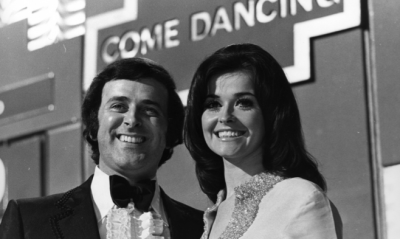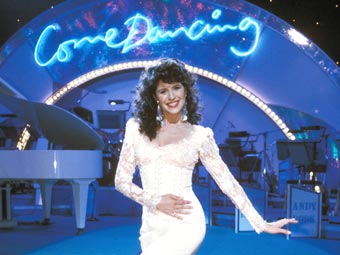Come Dancing
| Line 45: | Line 45: | ||
Series creator Eric Morley was the original Master of Ceremonies, assisted, and then succeeded, by a seemingly endless list of presenters. Just about everyone had a go at it down the years, from the barely-remembered (disc jockey Don Moss) to the fondly recalled (the inevitable Terry Wogan) and the frankly miscast (Noel Edmonds fronting a ballroom dancing competition? It happened.) | Series creator Eric Morley was the original Master of Ceremonies, assisted, and then succeeded, by a seemingly endless list of presenters. Just about everyone had a go at it down the years, from the barely-remembered (disc jockey Don Moss) to the fondly recalled (the inevitable Terry Wogan) and the frankly miscast (Noel Edmonds fronting a ballroom dancing competition? It happened.) | ||
| - | <div class="image">[[ | + | <div class="image">[[File:Comedancing wogan hostess blackwhite.png|400px]]''The most well know host of the show, [[Terry Wogan]]''</div> |
| - | + | ||
| - | '' | + | |
True enough, the show did seem a little anachronistic for much of its existence, but it did try to move with the times, with new styles like rock 'n' roll and disco added to the existing categories (we don't think there was ever a category for body popping, though). The glamour was always very much to the forefront, with the contestants' dresses always described in loving detail - including those rhinestones, which were invariably "sewn on by hand" (and how else would you attach them? Double-sided sticky tape?) | True enough, the show did seem a little anachronistic for much of its existence, but it did try to move with the times, with new styles like rock 'n' roll and disco added to the existing categories (we don't think there was ever a category for body popping, though). The glamour was always very much to the forefront, with the contestants' dresses always described in loving detail - including those rhinestones, which were invariably "sewn on by hand" (and how else would you attach them? Double-sided sticky tape?) | ||
| + | |||
| + | <div class="image">[[Image:Come_dancing_rosemarie_ford.jpg]]''One of the later hosts, [[Rosemarie Ford]]''</div> | ||
In the end, ''Come Dancing'' became one of those shows, like [[One Man and His Dog]], that were reassuringly always there, yet watched by smaller and smaller audiences. After years of being shunted around in the schedules, the axe finally fell in the mid-1990s. | In the end, ''Come Dancing'' became one of those shows, like [[One Man and His Dog]], that were reassuringly always there, yet watched by smaller and smaller audiences. After years of being shunted around in the schedules, the axe finally fell in the mid-1990s. | ||
Revision as of 03:01, 3 January 2017
Contents |
Host
Guest hosts (in order, but not including repeat performances): Barrie Edgar, Leslie Mitchell, Eric Morley, MacDonald Hobley, Sylvia Peters, Ron Randell, Jack McGeagh, David Jacobs, Peter Haigh, Peter West, Peter Dimmock, Paul Carpenter, George Elrick (1950-9)
Peter West (1959-72) [*]
Terry Wogan (1973-9) [*]
Peter Marshall (1980-3)
David Jacobs (1984-6) [*]
Angela Rippon (1988-91) [*]
Rosemarie Ford (1992-8) [*]
[*] Hosted the 50th Anniversary special on 29 December 1998
Co-hosts
Regional heats (in order, but not including repeat performances): Archie McCulloch, Nat Allen, Alun Williams, Jack Binks, Peter West, Alex Macintosh, Geoffrey Wheeler, Wally Green, Jameson Clark, Ron Boyer, John Langham, Roger Moffat, Bill Jack, Michael Aspel, MacDonald Hobley, Leslie Dunn, David Coleman, Keith Fordyce, Jack Watson, David Jacobs, Geoffrey Harvey, Malcolm Scrimgeour, Peter Haigh, Derek Batey, Judith Chalmers, Martin Muncaster, Alan Weeks, Leonard Maguire, Harold Williamson, Tom Salmon, Athole Still, Jimmy Young, James Lloyd, Brian Johnston, John Johnston, Gerald Harrison, Neville Powley, Meryl O'Keeffe, Evelyn Elliot, Bob Welling, Frank Bough, Michael Baguley, Brian Hoey, Malcolm Kellard, Don Moss, Jimmy Henney, Martin Locke, Peter Tuddenham, Bruce McKenzie, Mike Neville, Jeremy Carrad, Neil Durden-Smith, Billy Raymond, Pete Murray, John Benson, Peter Wheeler, Barry Chambers, John Bassett, Stuart Hall, Tim Brinton, Keith Ackrill, Barry Alldis, Larry McCoubrey, Clive Roslin, Joe Brady, Tim Gudgin, Desmond Carrington, Noel Edmonds, Terry Wogan, David Gell, David Findlay, Alan Towers, Ian Masters, John Craven, Barri Haynes, Tom Edwards (1957-73)
Commentators:
Barri Haynes (1974-8)
Ray Moore (1979)
Bruce Hammal (1980-4)
Charles Nove (1985-98)
Broadcast
BBC-tv/BBC1, 29 September 1950 to 11 September 1995 (competition format introduced 1953, no series in 1982 or 1987)
International Come Dancing specials: 11 & 18 September 1996 and 2 January 1998 (3 episodes)
"50th anniversary" special: 29 December 1998
Synopsis
Not merely the longest-running gameshow in the land, but at one time the longest running British TV show of any kind whatsoever. Launched in 1950 as a sort of companion piece to the already popular Television Dancing Club, the show originally had an educational outlook, with leading dancers of the day instructing viewers in how to do the various dances. After a while the format was re-jigged (if you'll pardon the pun), and in 1952 the familiar regional dance-offs and national final were introduced, with separate categories for each dance.
Series creator Eric Morley was the original Master of Ceremonies, assisted, and then succeeded, by a seemingly endless list of presenters. Just about everyone had a go at it down the years, from the barely-remembered (disc jockey Don Moss) to the fondly recalled (the inevitable Terry Wogan) and the frankly miscast (Noel Edmonds fronting a ballroom dancing competition? It happened.)
 The most well know host of the show, Terry Wogan
The most well know host of the show, Terry WoganTrue enough, the show did seem a little anachronistic for much of its existence, but it did try to move with the times, with new styles like rock 'n' roll and disco added to the existing categories (we don't think there was ever a category for body popping, though). The glamour was always very much to the forefront, with the contestants' dresses always described in loving detail - including those rhinestones, which were invariably "sewn on by hand" (and how else would you attach them? Double-sided sticky tape?)
 One of the later hosts, Rosemarie Ford
One of the later hosts, Rosemarie FordIn the end, Come Dancing became one of those shows, like One Man and His Dog, that were reassuringly always there, yet watched by smaller and smaller audiences. After years of being shunted around in the schedules, the axe finally fell in the mid-1990s.
Inventor
Eric Morley
Trivia
In 1963, the BBC's contract with Mecca Ballrooms (who owned the format) was up for renewal, and some of the ITV companies were looking to poach the show. The BBC couldn't compete financially, so what they did instead was despatch Alan Whicker to make a special not-for-broadcast edition of Whicker's World about the 70-year-old head of Mecca, Carl Louis Heimann, to leave for his recently-born second son. The gesture paid off, and Come Dancing stayed on the BBC.
Strange but true: for years and years, it was believed that Come Dancing had started in 1950, rather than 1949. The Guinness Book Of Records stated as much for over twenty editions. It was only when the BBC's 70th anniversary celebrations came around in 1992 that someone thought to check, and found that the previously quoted date was a year out. Oddly, the BBC's own Strictly Come Dancing Story documentary put a date of 1948 on it, for which we can find no evidence. They probably conflated it with the aforementioned Television Dancing Club which did indeed start in 1948 but continued its own separate existence until the mid-60s.
Reader Mike Sharp, who put us right on the subject of the attachment of sequins (stuck on with glue) as opposed to rhinestones (sewn on), also notes:
- On the subject of more "with it" dances, I still have the medal I was awarded in 1963/64 for winning the Twist contest when Home Counties South won the overall contest. In passing I was also a member of the winning formation team trained by Peggy Spencer.

